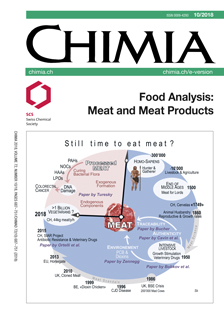Bioactive Compounds of Juice and Peels of Yuzu Fruits Cultivated in Switzerland
FH-HES Universities of Applied Sciences
DOI:
https://doi.org/10.2533/chimia.2018.728PMID:
30376926Keywords:
Antioxidant activity, Flavanone, Juice, Peel, Vitamin c, YuzuAbstract
Yuzu is a citrus fruit cultivated mainly in northeast Asia. Due to the huge gastronomic interest emerging in recent years, some attempts to grow yuzu in Europe are being made. Juice and peel of yuzu cultivated in Switzerland have been characterised in this study. Peel constituted the major part of yuzu fruit followed by flesh, juice and seeds. The fruit degree of maturity was investigated by measuring pH, total titratable acidity and total soluble solids of the juice. The analyses were pursued by determining the content of vitamin C, malic and citric acids amounting to 0.560, 6.18 and 44.7 g/L, respectively. Four flavanones: naringin, hesperidin, naringenin, and hesperetin were identified and quantified in both juice and peel. The most abundant flavanone was hesperidin with 47 ?g/mL and 640 ?g/g dry matter (DM) in juice and peel, respectively. For the first time yuzu grown in Switzerland have been analysed and the obtained values have been compared with literature for other citrus fruits. Yuzu juice showed higher contents of citric and malic acid. Yuzu cultivated in Switzerland contained nearly twice as much vitamin C as yuzu juices from different regions of Japan. The content of vitamin C of yuzu was as high or higher than in most other citrus fruits. Large differences in the content of flavanones in yuzu juice from different regions of Japan were reported, in general the values noted were lower than those in the present study.Downloads
Published
2018-10-31
Issue
Section
Columns, Conference Reports
Categories
License
Copyright (c) 2018 Swiss Chemical Society

This work is licensed under a Creative Commons Attribution-NonCommercial 4.0 International License.
How to Cite
[1]
A. Sprunger, I. Marmillod, A. Kosińska-Cagnazzo, W. Andlauer, Chimia 2018, 72, 728, DOI: 10.2533/chimia.2018.728.







